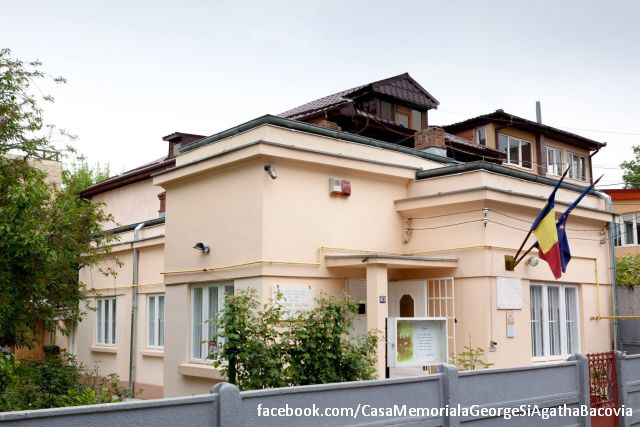The domestic universe of poet George Bacovia
The “George and Agatha Bacovia Memorial House lies on the outskirts of Bucharest

Christine Leșcu, 03.04.2021, 13:30
On one of Bucharests interwar outskirts, to this day a rather modest neighbourhood of Romanias capital city, lies the small, seemingly insignificant, yet welcoming home of early 20th Century poet George Bacovia.
Labelled by literary critics a symbolist poet, only to be included in a movement, Bacovia still charms his readers with his simple, sad poems that reflect and grant beauty to despondency. In fact, the sadness in his poetry was a reflection of his fragile and depressive nature.
Bacovias survival depended mostly on his wife, Agatha, whom we also owe the existence of the small “George and Agatha Bacovia Memorial House. Curator Lelia Spirescu with the National Museum of Romanian Literature in Bucharest told us more about this house and its location on the outskirts of the capital city.
Lelia Spirescu: “This was a ‘democratic area or neighbourhood, as the poet liked to call it. It was part of the underprivileged, proletarian world, rather than a wealthy suburb. Obviously, it matched his soul perfectly. Well, George Bacovia confessed at some point that most of his memories, both as a child and as a grownup, were tied to the town of Bacău. But it was in this house that he came to live together with and due to his wife, Agatha Grigorescu. She took a loan from the Teachers Association and managed to have this house built in record time, about one month. And she also oversaw the construction works. As I was saying, this place seemed tailored to his soul. George Bacovia was an introvert, a man who kept to himself, prone to sickness, fragile in both physical and psychological terms. He suffered from depression as well. Agatha on the other hand was an optimist, a fighter, all her life. Its true, she had no choice but to be one. She was his pillar of strength, both during his lifetime and after he died. She wanted his literary legacy to last forever, so she donated the house to the state, and it became a museum as early as in 1958, one year after the poet died.
Although he spent most of his life in Bucharest, George Bacovia was deeply marked by his hometown of Bacău, in the east of the country.
Lelia Spirescu: “Poet George Bacovia was born in Bacău on September 17, 1881, into a merchant family with a lot of children. Gheorghe Andone Vasiliu, known under his penname of George Bacovia, had 10 siblings. His first contact with Bucharest was in fact in 1903, when he came here to attend Law School, but he quit after the first 3 years. In 1907 he joined the Law School in Iaşi, where he graduated in 1911. He would move back and forth between Bucharest, Bacău and Iași. His wife was born in Mizil, Prahova County, in the south, on March 8, 1895 and her childhood was by no means easy. She lost her mother just days after she was born, and her father died when she was 15. She had 2 sisters, and she was raised by her family. She met the poet George Bacovia in 1916. She graduated from the School of Literature and Philosophy and she taught Romanian language and literature. She would also work as a substitute French teacher. She was a poet, too. She made her debut in 1923 with a poetry volume entitled “Twilight harmonies.
Agatha provided George with the material and psychological support that he needed so much, and designed the house in Bucharest as a shelter for him and as a home that would reflect her personality as well, as Lelia Spirescu told us:
Lelia Spirescu: “This house is quite modest, quiet, combining energies that were defining both for Agatha, and for George. The light and brightness of the house makes us think of her optimism, whereas the modesty and the dark tones of the furniture represent George Bacovia. These energies are present in the house to this day. You can feel both of them here when you visit the place.
With only 3 rooms and a few small utilities rooms, the George and Agatha Bacovia Memorial House is filled with the couples personal items: furniture, books, radio sets, paintings, the violin that the poet used to play.
Lelia Spirescu: “He loved drawing and music to the same extent. It was actually for drawing that he won his first prize ever, in 1899. That year was a landmark for him in 2 respects, because in 1899 he made his debut with the “Literatorul magazine run by poet Alexandru Macedonski, and also he won a top national place in a still nature drawing competition. He was also keen on music, which was actually his first love. He found music in his middle school years, when he played in the school orchestra and even got to conduct this orchestra with such talent that his music teacher advised him to go to the Music Conservatory. He didnt, he eventually chose poetry, but he remained loyal to music as well. His favourite instrument was the violin, and I think no other instrument could have resonated better with his emotions.
After Bacovias death, the building and items in it were declared a “public utility collection managed by the poets wife and son, and in 1966, when the house was donated to the government, it was turned into a memorial museum. (tr. A.M. Popescu)






























